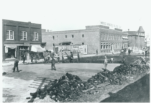Science Smarts: Puzzled by science!
By Patty Rooks on February 24, 2024.
I visit many classrooms and students each and every year. If I was to count, I would say I have literally seen tens of thousands of students throughout my career. Although I have seen so many students, it is still exciting each and every time. I love to get up and go to work! One of the most exciting parts of doing what I do is seeing the students’ faces when I puzzle them all in the name of science. They look at me and cannot figure out what happened. I love it. I will share one of my latest puzzles with you. Let’s get started! *Remember to ask an adult before you do this experiment. Materials – Balloons – Goggles – Barbecue lighter – Candle – Measuring cups – Funnel – Water Procedure 1. Do this BEFORE your audience comes in. 2. Blow up one balloon, tie it and set it aside. 3. Fill a second balloon with 60 mL of water (use the funnel to help you with this), tie and set beside the other one. 4. Bring your audience in. 5. Put on your safety goggles. 6. Have an ADULT light a candle. Tell your audience that you are going to hold a balloon over the flame. Ask them what they think will happen. 7. Hold the balloon WITHOUT water over the flame. Observe. 8. What happens? Why? What happens to the candle (probably)? 9. Light the candle again and place it under the balloon with water in it. What happens? Do you know why? What is going on? In this experiment it was observed that one balloon popped while the other was perfectly fine (well for as long as we did it). You may wonder how is this possible because both balloons had air in them. Yes, they did, but air is not enough to keep the balloon from popping. Once the balloon is heated up, and the air inside gets too hot and the rubber from the balloon begins to weaken as well from the heat; there is nothing left to do but POP! The balloon with the water in it on the other hand does not pop quite so easily (you have to keep the flame on the water). This is due to the water absorbing the heat faster than the air because water has a higher heat capacity than air. When the flame was placed underneath the balloon the rubber did not absorb as much of the heat because the water inside of the balloon absorbed it. In return the rubber does not become weak as quickly. Since the water absorbs the heat instead of the balloon there is less pressure on the rubber and less pressure from the air inside the balloon and this prevents it from popping. Keep an eye out for the Regional Science Fair Registration are now open. Mark your calendars as the Virtual Science Fair registration deadline is March 4 and the in person science fair will be on March 23 at Medicine Hat College. I hope to see you there! Patty Rooks, senior scientific consultant PRAXIS, “Connecting Science To The Community.” Contact Praxis at praxis@praxismh.ca, http://www.praxismh.ca, Tweet or follow us @PraxisMedHat, or friend us on Facebook. Address: 12 826 11th Street SE, Medicine Hat, AB, T1A 1T7 Phone: 403-527-5365, email: praxis@praxismh.ca. 30-29




